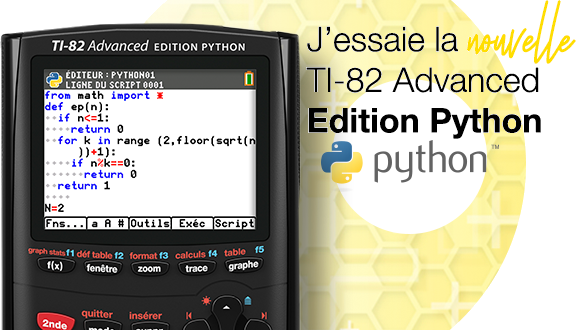Resultat : ca marche bien sur Nspire CX ou j'ai une version compatible KhiCAS Xcas et KhiCAS MicroPython (cf. ci-dessous), mais sur Numworks, il n'y a pas assez de ressources et donc sur Casio ce sera pareil. Enfin, en grattant de partout, on y arrive tout juste, mais KhiCAS devient alors instable, donc je ne mets en ligne que la version MicroPython KhICAS
https://workshop.numworks.com/python/parisseb/solaire, elle n'a pas besoin du script de compatibilite de critor.
Attention, pour la compatibilite, j'ai du faire une mise a jour de KhiCAS pour TI et pour Numworks pour y ajouter la commande draw_filled_circle (cote Xcas) et accepter un parametre de couleur de fonds pour la commande draw_string (cote MicroPython).
Donc voila le code KhiCAS compatible MicroPython/Xcas pour ti nspire (fonctionne aussi sur Numworks MicroPython)
- Code: Select all
# Solar v.1.01 NW 23/10/2020
# d'apres https://nsi.xyz/solar
# Jil Saint-Martin et Emmy Vadon
from math import *
from random import *
from kandinsky import *
from cas import *
screen_w=320
screen_h=222
font_h=16
systeme = [["Soleil",'centre du syteme solaire','0','1,989 × 10^30','696340', '0'],
["Mercure",'88','57','3,285 × 10^23','2439.7', '0'],
["Venus",'225','104','4,867 × 10^24','6051.8', '0'],
["Terre",'365','150','5,972 × 10^24','6371', 'Lune'],
["Mars",'687','220 ','6.39 × 10^23 ','3389,5','2'],
["Jupiter",'12','780 ','1.898 × 10^27','69911','3'],
["Saturne",'29','1,493','5.683 × 10^26','58232','~ 200'],
["Uranus",'84','2,9592','8.681 × 10^25','25362','27'],
["Neptune",'165','4,4762','1.024 × 10^26','24622','14']
]
coord = [[160,111,16], [180,110,6], [185,95,8], [120,100,9], [160,160,9], [115,150,15], [200,50,12], [170,20,9], [55,80,8]]
for k in range(len(coord)):
coord[k][0] = coord[k][0]*screen_w//320
coord[k][1] = coord[k][1]*screen_h//222
coord[k][2] = coord[k][2]*screen_w//320
couleur1 = [[255,255,0], [251,136,7], [190,183,150], [30,160,173], [245,0,0], [162,125,105], [200,169,133], [191,209,232], [0,33,240]]
couleur2 = [[235,128,0], [106,73,32], [121,104,83], [6,67,29], [101,12,12], [134,56,32], [189,138,80], [117,163,224], [5,15,81]]
c_blanc=65535
def anneau(x0,y0,r,c,E):
for i in range(2*E):
rt = max(0,r-i*0.5)
if rt:
draw_circle(x0,y0,int(rt),c)
def degrade(c1,c2,k):
return [c1[0]+int(k*(c2[0]-c1[0])),c1[1]+int(k*(c2[1]-c1[1])),c1[2]+int(k*(c2[2]-c1[2]))]
def cercle_degrade(x0,y0,R,c1,c2,E):
for i in range(R):
anneau(x0,y0,i,degrade(c1,c2,i/R),1)
def RGB(r,g,b):
return (((r*32)//256)*2^11) + (((g*64)//256)*2^5) + ((b*32)//256)
def tirage(n):
c=[RGB(235,128,0),RGB(13,89,175),RGB(13,89,175),RGB(44,122,211),RGB(207,230,230),RGB(207,230,230)]
c.append(c[0])
sw2=screen_w/2.0
sh2=screen_h/2.0
Coeff=1.0/(screen_w/10.0+.5)
for i in range(n):
x=randint(0,screen_w)
y=randint(0,screen_h)
d=sqrt((x-sw2)**2+(y-sh2)**2)*Coeff
di=int(d)
fill_rect(x,y,2,2,c[di]+int((d-di)*(c[di+1]-c[di])))
def drawstring(s, x, y, cf,cb=0):
print(s)
draw_string(x,y,s,cf,cb)
def solar_systeme_dessine(n, Degrade=1):
# Affiche un corps du sytème solaire, numéro du corps dans systeme[], degradé
if Degrade:
cercle_degrade(coord[n][0], coord[n][1], coord[n][2], couleur1[n], couleur2[n],2 + 9 * (n != 0))
else:
draw_filled_circle(coord[n][0], coord[n][1], coord[n][2], c_blanc)
def solar_systeme_texte(n=42, t=0): #affichage du texte en bas, de couleur associée à omega, avec les diverse infos
os=RGB(255,183,52)
if n == 42 :
fill_rect(1,screen_h-font_h,screen_w,font_h,os)
drawstring("nsi.xyz/solar par Emmy & Jil ",2,screen_h-font_h,c_blanc,os)
else:
fill_rect(1,screen_h-font_h,screen_w,font_h,os)
s = systeme[n][t]
if t==1 and n:
s = "periode de revo: " + s + ((n <=4 ) and " jours" or " ans")
elif t==2:
s = "dis soleil: " + s + " milli" + ((n <= 5 ) and "on" or "ard") + "s km"
elif t==3:
s = "masse: " + s + " kg"
elif t==4:
s = "rayon: " + str(s) + " km"
elif t==5:
s = "satellites connus: " + str(s)
drawstring(s,2,screen_h-font_h,c_blanc,os)
def navigation(): #navigation grâce aux flèches
Position = 0
texte = 0
key = 0
while key != 9 and key!=5 :
show()
key = get_key()
if key>=0 and key<=3:
if key==0 or key==3: #Gauche Droite
avant = Position
Position = min(max(Position+2*(key==3)-1, 0), 8) # le soleil [0] + 8 planète
if avant != Position:
solar_systeme_dessine(avant)
solar_systeme_dessine(Position, 0)
elif key==1 or key==2: #haut bas
texte = max(min(texte + 2*(key==2) - 1, 5), 0) # Il faut donc avoir 5 données en plus du nom dans systeme[]
solar_systeme_texte(Position,texte)
#sleep(0.120)
def main():
fill_rect(0,0,screen_w,screen_h,0)
cercle_degrade(screen_w//2,screen_h//2,197*screen_w//320,[0,35,143],[0,0,0],10)
cercle_degrade(screen_w//2,screen_h//2,40*screen_w//320,couleur2[0],[0,35,143],2)
cercle_degrade(screen_w//2,screen_h//2,coord[0][2],couleur1[0],couleur2[0],2)
tirage(250)
set_pixel()
r_orb = (22,32,42,52,62,76,92,109)
for i in range(8):
anneau(screen_w//2,screen_h//2,r_orb[i],[119,135,135],1)
solar_systeme_texte()
solar_systeme_dessine(0,0)
set_pixel()
#sleep(0.1)
solar_systeme_dessine(0)
for k in range(1,9):
cercle_degrade(coord[k][0],coord[k][1],coord[k][2],couleur1[k],couleur2[k],10)
navigation()
main()
(Edit: correction de coeff en Coeff, car coeff est une commande interne Xcas)




















